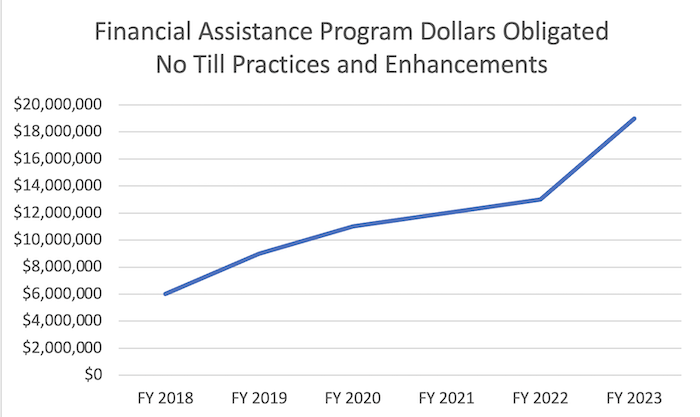It’s an exciting time for no-till. Thanks to the Inflation Reduction Act, part of President Biden’s Investing in America agenda, a historic amount of funding is available to America’s farmers and ranchers for climate-smart practices like no-till. Over the years, USDA’s Natural Resources Conservation Service has provided ample financial assistance for no-till — $6 million in 2018, $9 million in 2019, $11 million in 2020, $12 million in 2021 and $13 million in 2022. But thanks to additional funds through the Inflation Reduction Act, 2023 surpassed all previous years — $19 million in financial assistance through 1,700 contracts for no-till, the highest amount in history. And we’re looking forward to strong investments in 2024.
But you know, it’s not just about the dollars. Through these practices, producers are increasing production, saving on inputs, growing efficiencies on their operations and conserving resources for future generations.
First – Let's talk about the Inflation Reduction Act, and why it’s important.
The Inflation Reduction Act is enabling the largest investments in voluntary conservation in history. On top of existing Farm Bill funds, the Inflation Reduction Act provides an additional $19.5 billion over 5 years to support USDA’s conservation programs that yield climate change mitigation benefits. In total, NRCS provided $2.8 billion in financial assistance last year through the Inflation Reduction Act and Farm Bill, supporting 45,000 contracts with farmers, ranchers and forest landowners to conserve natural resources on their land.
This year, NRCS is making over $3 billion available from the Inflation Reduction Act in addition to the $2 billion in existing Farm Bill funding. That provides a large amount of funding and an opportunity for all conservation-minded producers – including no-till farmers – to receive assistance.
NRCS isn’t doing this alone. Through USDA’s Partnerships for Climate-Smart Commodities effort, the agency is working with partners to build and expand market opportunities for American commodities produced using climate-smart practices through approximately 140 pilot projects. The initiative is anticipated to provide financial and technical assistance to producers to implement climate-smart production practices on more than 60,000 farms, encompassing more than 25 million acres of working land. Of those, 87 projects are offering assistance to producers for practices including no-till and reduced till.
Second – We want you to be aware that no-till is climate-smart.
The Inflation Reduction Act supports key climate-smart practices that help mitigate climate change, what we call our Climate-Smart Agriculture and Forestry Mitigation Activities. This activities list, of course, includes no-till. That’s because we know no-till works. By reducing soil disturbance and utilizing crop residues, no-till can reduce the amount of carbon dioxide released into the atmosphere from the soil, as compared to conventional tillage that breaks up the soil and increases emissions. By reducing the number of times that a tractor passes a field, no-till can also reduce fuel consumption, thereby reducing fossil fuel emissions while also saving time and money for a farmer. Over time, continuous no-till may increase carbon storage in the soil, while also delivering important co-benefits such as reducing soil erosion, increasing plant-available moisture and improving water quality. By enriching the soil with organic matter and improving soil health, no-till also has the potential to increase soil water-holding capacity, which may also help increase resilience to climate change impacts such as drought and changes in precipitation.
Finally – We got this! NRCS is getting funding out to producers on the ground, and our conservation programs are making a big difference for producers across the country.
In fiscal year 2023, NRCS obligated 99.8 percent of all available Inflation Reduction Act financial assistance funds to farmers, ranchers, and forest landowners across America. We recently released updated state-by-state data showing where investments went in fiscal year 2023, and where investments are going in fiscal year 2024, for the Farm Bill and Inflation Reduction Act.
One example of a no-till farmer benefitting from NRCS conservation programs is Josh Daniels of Dalmatia, Penn. With his new fiscal year 2023 EQIP contract funded by the Inflation Reduction Act, Josh plans to establish field borders to decrease the chances of runoff from reaching the nearby creeks. In addition, he has begun efforts to support and protect pollinators by creating an area of land intentionally set aside and managed to provide habitat for pollinators like bees, butterflies, and other insects. Josh also plans to use the funds to maintain wildlife cover, which will help provide a safe and sheltered place for animals to feed, breed, and find refuge. Finally, he hopes to continue work from his previous NRCS contracts (including cover crops and no-till) in a sustainable approach to continue benefitting the land passed down to him from his father.
Whether you’re continuing your no-till practices, or converting land to no-till, NRCS has financial and technical assistance available to help. If you’re interested in applying for assistance, please contact NRCS at your local USDA Service Center.
Related Content
Capitalize on Conservation with Funding Programs
[Podcast] Find Funding for Cover Crops with New Online Incentive Tool







Post a comment
Report Abusive Comment